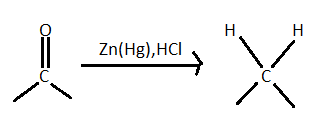
(A) is subjected to reduction with $Zn - Hg/HCl$ and the product formed is N-methylmethanamine. (A) can be:
A. Ethane nitrile
B. Nitroethane
C. Carbylamine ethane
D. Carbylamino methane
Answer
219.9k+ views
Hint : We can solve this problem with the help of Clemmensen Reduction reaction.
Complete step by step solution:
> As it is given in the problem statement that (A) is subjected to reduction with $Zn - Hg/HCl$ so it is clearly a clemmensen reduction reaction. In this reaction aldehydes and ketones (carbonyl group) with zinc amalgam $(Zn/Hg)$ in concentrated hydrochloric acid reduce the aldehydes or ketone to a hydrocarbon. The mercury alloy does not participate in the reaction it just used to provide a clean active metal surface.

This reduction involves heating a carbonyl compound with finely divided amalgamated zinc in hydroxylic solvent which contains a mineral acid such as hydrochloric acid. In clemmensen reduction nitro group is also reduced in presence of zinc amalgam and concentrated hydrochloric acid but nitro group containing compounds reduces very slowly. This reaction reduces $RCN$ to amine ($RC{H_2}N{H_2}$) and isocyanide compounds to $RNHC{H_3}$. Here in the problem it is given that the product is N-Ethylmethylamine. So it is clear that there is a isocyanide group in the A and $R$ is methyl group $C{H_3} - $ as it gives a compound which has only two carbon.
$A \to C{H_3} - NH - C{H_3}$ $ \Rightarrow $So know we know that the compound (A) is $C{H_3} - NC$ which is carboxyl amino methane.

Hence the last option, that is option D is the correct answer to this problem.
Note : : We have approached this reaction with clemmensen reduction. In this reaction it reduces carbonyl group to simple hydrocarbons. Thus the compound A is here $C{H_3} - NC$ which carbylamine methane. In the problem the product is given which makes it very easy for us to determine compound (A) as we know that compound that contains iso cyanide group give such type products.
Complete step by step solution:
> As it is given in the problem statement that (A) is subjected to reduction with $Zn - Hg/HCl$ so it is clearly a clemmensen reduction reaction. In this reaction aldehydes and ketones (carbonyl group) with zinc amalgam $(Zn/Hg)$ in concentrated hydrochloric acid reduce the aldehydes or ketone to a hydrocarbon. The mercury alloy does not participate in the reaction it just used to provide a clean active metal surface.

This reduction involves heating a carbonyl compound with finely divided amalgamated zinc in hydroxylic solvent which contains a mineral acid such as hydrochloric acid. In clemmensen reduction nitro group is also reduced in presence of zinc amalgam and concentrated hydrochloric acid but nitro group containing compounds reduces very slowly. This reaction reduces $RCN$ to amine ($RC{H_2}N{H_2}$) and isocyanide compounds to $RNHC{H_3}$. Here in the problem it is given that the product is N-Ethylmethylamine. So it is clear that there is a isocyanide group in the A and $R$ is methyl group $C{H_3} - $ as it gives a compound which has only two carbon.
$A \to C{H_3} - NH - C{H_3}$ $ \Rightarrow $So know we know that the compound (A) is $C{H_3} - NC$ which is carboxyl amino methane.

Hence the last option, that is option D is the correct answer to this problem.
Note : : We have approached this reaction with clemmensen reduction. In this reaction it reduces carbonyl group to simple hydrocarbons. Thus the compound A is here $C{H_3} - NC$ which carbylamine methane. In the problem the product is given which makes it very easy for us to determine compound (A) as we know that compound that contains iso cyanide group give such type products.
Recently Updated Pages
Electricity and Magnetism Explained: Key Concepts & Applications

JEE Energetics Important Concepts and Tips for Exam Preparation

JEE Isolation, Preparation and Properties of Non-metals Important Concepts and Tips for Exam Preparation

JEE Main 2021 July 25 Shift 1 Question Paper with Answer Key

JEE Main 2021 July 22 Shift 2 Question Paper with Answer Key

States of Matter Chapter For JEE Main Chemistry

Trending doubts
JEE Main 2026: Application Form Open, Exam Dates, Syllabus, Eligibility & Question Papers

Derivation of Equation of Trajectory Explained for Students

Hybridisation in Chemistry – Concept, Types & Applications

Understanding the Angle of Deviation in a Prism

Understanding Atomic Structure for Beginners

How to Convert a Galvanometer into an Ammeter or Voltmeter

Other Pages
Solutions Class 12 Chemistry Chapter 1 CBSE Notes - 2025-26

NCERT Solutions For Class 12 Chemistry Chapter 1 Solutions - 2025-26

The D and F Block Elements Class 12 Chemistry Chapter 4 CBSE Notes - 2025-26

NCERT Solutions for Class 12 Chemistry Chapter Chapter 7 Alcohol Phenol and Ether

NCERT Solutions ForClass 12 Chemistry Chapter Chapter 8 Aldehydes Ketones And Carboxylic Acids

JEE Advanced Marks vs Ranks 2025: Understanding Category-wise Qualifying Marks and Previous Year Cut-offs




